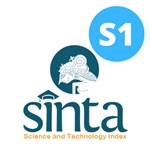HUBUNGAN BEBAN KERJA DAN KONSUMSI AIR MINUM DENGAN DEHIDRASI PADA PEKERJA PABRIK TAHU
Downloads
Dehidration can significantly impact the workers of Tahu UD Sumber Kencana Factory due to workplace climate of warm environments. In addition, high metabolism also occurs because of job duties. Workers who inadequate hydrated while working lead to dehydration. This study aims to reveal the relationship of hydration status between workload and water intake. By applying observational research with cross sectional approach, this study obtained 14 workers in tahu (tofu) and cincau production. Workload data was collected by using 10 pulse measurement method by Kilbon (1992), while water intake measurement was conducted with observation sheet of NIOSH (2011). The urine colors chart by Armstrong (1994) and Armstong (1998) was used to indicate the hydration status of workers. The results showed that workload measurement included in mild and moderate category, whereas water intake measurement was mostly indicated workers in low category. Assessing the worker's hydration status signified varied findings that were included mild, moderate, and severe category. The statistic analysis of Spearman's rank correlation showed that the workload had low relation to dehydration (r = 0.094) and had high relation between water intake and hydration (r = 0.882). According to results, it can be concluded that dehydration is more likely to occur to workers with low water intake while working.
Keywords: dehydration, water intake, workload
Andayani, K., 2013. Hubungan Konsumsi Cairan dengan Status Hidrasi pada Pekerja Industri Laki-Laki. Artikel Penelitian. Semarang: Fakultas Kedokteran Universitas Diponegoro Semarang
Armstrong, L.E., 2007. Assessing Hydration Status: The Elusive Gold Standard. Journal of the American College of Nutrition, [e-Journal] 26(5): pp. 575S–584S
Armstrong, L. E., Maresh, C. M., Castellani, J. W., Bergeron, M. F., Kenefick, R. V., LaGasse, K. E., & Riebe, D. 1994. Urinary Indicies of Hydration Status. Int. J. Sport Nutrition, [e-Jorunal] 4(3): pp. 265–269
Armstrong, L. E., Maresh, C. M., Castellani, J. W., Bergeron, M. F., Kenefick, R. V., LaGasse, K. E., & Riebe, D., 1998. Urinary Indicies Uduring Dehydration, Exercise, and Rehydration. Int. J. Sport Nutrition, [e-Journal] 8(4): pp. 345–355
Fajrin, N., Naiem, F., dan Rahim, R., 2014. Faktor yang Berhubungan dengan Keluhan Kesehatan Akibat Tekanan Panas pada Pekerja Instalasi Laundry Rumah Sakit di Kota Makassar. Media Kesehatan Masyarakat Indonesia, pp. 1-11
Maharja, R., 2015. Analisis Tingkat Kelelahan Kerja berdasarkan Beban Kerja Fisik Perawat di Instalasi Rawat Inap RSU Haji Surabaya. The Indonesian Journal of Occupational Safety and Health, [e-Jurnal] 4 (1): pp. 93–102
Margiasih, O.A., 2016. Hubungan Beban Kardiovaskuler dengan Dehidrasi dan Kelelahan pada Pekerja Bagian Penempaan Besi di Sentra Industri Pande Besi Desa Padas Kecamatan Karanganom Kabupaten Klaten. Publikasi Ilmiah. Surakarta: Fakultas Ilmu Kesehatan Universitas Muhammadiyah Surakarta
NIOSH, 2011. Protecting Workers from Heat Illness. Washington D.C: NIOSH
Puspita, A. D., 2015. Iklim Kerja dan Beban Kerja terhadap Tingkat Dehidrasi Pekerja Shift Pagi Bagian Injection Moulding 1 PT. X Sidoarjo. Skripsi. Surabaya: Fakultas Kesehatan Masyarakat Universitas Airlangga
Sari, N. P., 2014. Pengaruh Iklim Kerja Panas terhadap Dehidrasi dan Kelelahan pada Tenaga Kerja Bagian Boiler di PT Albasia Sejahtera Mandiri Kabupaten Semarang. Skripsi. Solo: Fakultas Ilmu Kesehatan Universitas Muhammadiyah Surakarta
Sherwood, L.I., 2011. Fisiologi Manusia. Jakarta: EGC
Soedirman, Suma'mur, P.K., 2014. Kesehatan Kerja dalam Perspektif Hiperkes & Keselamatan Kerja. Jakarta: Penerbit Erlangga
Soeripto, M., 2008. Higiene Industri. Jakarta: Balai Penerbit FKUI
Suma'mur, P. K., 2009. Higiene Perusahaan dan Keselamatan Kerja. Jakarta: CV Haji Mas Agung
Tarwaka, Solichul, H., Bakri, A., dan Sudiajeng, L., 2004. Ergonomi – untuk Keselamatan, Kesehatan Kerja & Produktivitas. Jakarta: Penerbit Buku Kedokteran
Undang-Undang Republik Indonesia Nomor 13 Tahun 2003 Tentang Ketenagakerjaan. Jakarta: DPR RI

In order to be accepted and published by The Indonesian Journal of Occupational Safety and Health, Author(s) who submit an article should complete all the review process. The copyright of received articles assigned to the The Indonesian Journal of Occupational Safety and Health and Department of Safety and Health, Universitas Airlangga as publishers of the journal. The intended copyright includes the rights to publish articles in various forms (including reprints).
The Editorial Team of The Indonesian Journal Of Occupational Safety and Health and Department of Safety and Health strive to ensure that no errors occur in the articles that have been published, both data errors and statements in the article.
Users of this website will be licensed to use materials from this website following the Creative Commons Attribution-NonCommercial-ShareAlike 4.0 International License. No fees charged. Please use the materials accordingly.
------------------------------------------------------------------------------------------------------------------------------------------------------------------------------------------
Attribution ” You must give appropriate credit, provide a link to the license, and indicate if changes were made. You may do so in any reasonable manner, but not in any way that suggests the licensor endorses you or your use.
NonCommercial ” You may not use the material for commercial purposes.
ShareAlike ” If you remix, transform, or build upon the material, you must distribute your contributions under the same license as the original.







 How to Submit Articles in OJS
How to Submit Articles in OJS

























